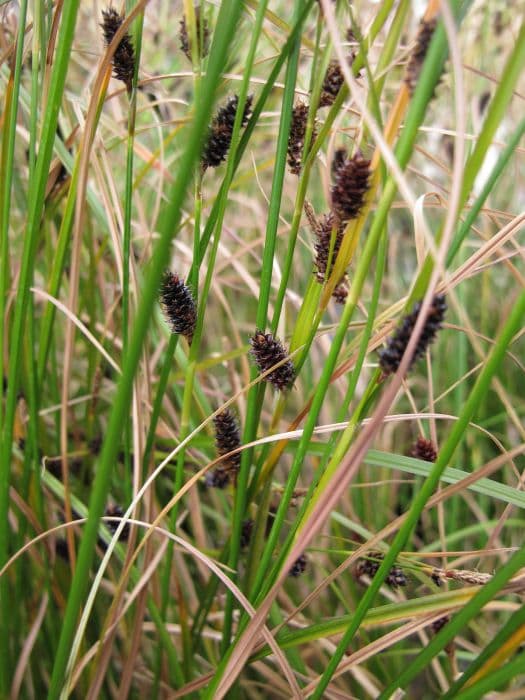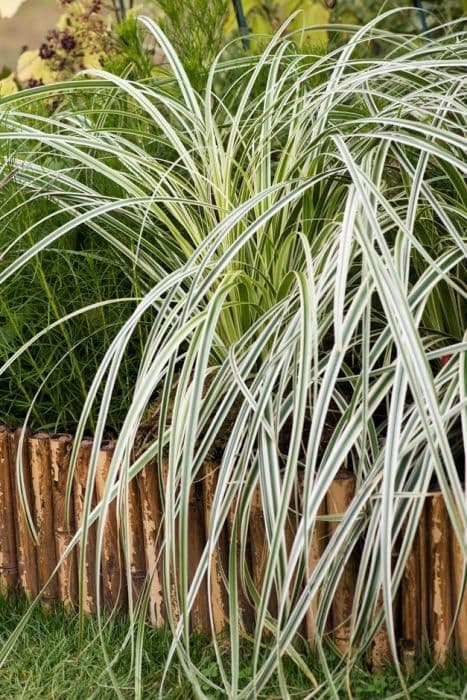Silver Sceptre Sedge Carex 'Silver Sceptre' (v)

ABOUT
Carex 'Silver Sceptre,' commonly known as Variegated Japanese Sedge, is a visually striking ornamental grass. It features slender, arching leaves that are edged with creamy white borders, giving it a delicate and refined appearance. The foliage of this sedge forms dense, fountain-like clumps, creating an elegant texture in the landscape. The leaves themselves possess a sense of movement due to their arching nature and the contrasting green and white variegation sparkles when it catches the light. This variegation also adds depth and dimension to the plant, drawing the eye and serving as an excellent complement to other plants in a garden setting. During the growing season, Variegated Japanese Sedge may produce small, inconspicuous flowers or spikes, but these are not the main attraction and often blend into the foliage. This plant offers year-round interest, with its foliage providing a bright spot in the garden even in the cooler months.
About this plant
 Names
NamesFamily
Cyperaceae
Synonyms
Silver Sceptre Sedge, Variegated Japanese Sedge
Common names
Carex 'Silver Sceptre'
 Toxicity
ToxicityTo humans
Carex 'Silver Sceptre', commonly known as variegated sedge, is not known to be toxic to humans. Therefore, ingesting parts of the plant should not cause any poisoning symptoms. However, as with any plant material, individual allergies or sensitivities are possible.
To pets
The variegated sedge is not known to be toxic to pets either. It's generally considered safe for dogs, cats, and other animals if they happen to ingest it. There should be no symptoms of poisoning from consuming this plant. However, ingestion of non-food items can sometimes lead to gastrointestinal upset in pets.
 Characteristics
CharacteristicsLife cycle
Perennials
Foliage type
Evergreen
Color of leaves
Variegated
Height
1-2 feet (30-60 cm)
Spread
1-2 feet (30-60 cm)
Plant type
Grass
Hardiness zones
5-9
Native area
Japan
Benefits
 General Benefits
General Benefits- Low Maintenance: Carex 'Silver Sceptre', commonly known as variegated sedge, requires minimal upkeep once established.
- Ornamental Appeal: Its variegated foliage adds visual interest to garden beds, borders, or containers.
- Erosion Control: The plant's dense root system can help stabilize soil and control erosion on slopes or banks.
- Habitat Support: Provides cover and nesting material for wildlife like birds and beneficial insects.
- Tolerant of Various Conditions: Variegated sedge adapts to a range of soil types and moisture levels.
- Year-Round Interest: Evergreen in many climates, it offers visual appeal throughout the seasons.
- Deer Resistant: Generally not preferred by deer, making it suitable for gardens in areas with deer populations.
- Flexible Planting Options: Can be planted alongside water features or in dry shade, showcasing its versatility.
- Drought Tolerant: Once established, it can survive periods of low water availability.
- Texture Contrast: Its fine, arching foliage contrasts well with plants having broader leaves.
 Medical Properties
Medical PropertiesThis plant is not used for medical purposes.
 Air-purifying Qualities
Air-purifying QualitiesThis plant is not specifically known for air purifying qualities.
 Other Uses
Other Uses- Crafting Material: The slender, variegated leaves of Carex 'Silver Sceptre' can be woven into small baskets or decorative mats due to their flexibility and strength.
- Garden Borders: Its compact size and variegation make Carex 'Silver Sceptre' an excellent choice for creating visually appealing garden borders that stand out against green lawns.
- Erosion Control: Planting this sedge on slopes or areas prone to erosion can help stabilize soil and prevent the washing away of important topsoil.
- Water Features: As a plant that enjoys moist conditions, Carex 'Silver Sceptre' can be planted around ponds or streams to enhance the naturalistic appearance of water features.
- Winter Interest: In regions where the plant remains evergreen, it can provide color and texture to gardens during the dull winter months.
- Photography Backdrop: The fine texture and variegation provide a subtle backdrop for photographing insects and other small creatures in close-up nature photography.
- Art Projects: Dried leaves of the sedge can be used in art projects for collage materials or as a natural element in mixed media artworks.
- Fairy Gardens: Due to its miniature and delicate appearance, Carex 'Silver Sceptre' is suitable for creating or enhancing fairy garden designs.
- Grave Plantings: Its low maintenance and subdued appearance make it a respectful and enduring choice for planting on graves or in memorial gardens.
- Education Tool: Carex 'Silver Sceptre' can be used in educational settings to teach about plant structures, variegation, and the care of ornamental grasses.
Interesting Facts
 Feng Shui
Feng ShuiThe plant Carex 'Silver Sceptre', commonly known as Sedge, is not typically used in Feng Shui practice.
 Zodiac Sign Compitability
Zodiac Sign CompitabilityThe plant Sedge is not used in astrology practice.
 Plant Symbolism
Plant Symbolism- Peace: The Carex 'Silver Sceptre,' also known as variegated sedge, often symbolizes tranquility and peace due to its soft, flowing form and delicate foliage which create a soothing visual effect in gardens.
- Brightness: The silver streaks in 'Silver Sceptre' can represent brightness and optimism, bringing lightness to shaded garden areas both literally and symbolically.
- Resilience: As sedges are generally hardy and adaptable plants, they often symbolize resilience and the ability to thrive in varying conditions.
- Balance: The balanced variegation of light and dark in the leaves can symbolize equilibrium and harmony in life.
 Water
WaterThe Variegated Sedge should be kept consistently moist, so it requires regular watering. Water this plant deeply when the top inch of the soil feels dry to the touch, which typically might be once or twice a week depending on the climate and soil drainage. Ensure you provide enough water to soak the soil around the roots, using roughly 1 gallon of water per square foot of soil every time you water. During the hotter, drier months, the need for watering may increase, and conversely, during the cooler or rainy seasons, the need to water will decrease. Avoid letting the Variegated Sedge sit in waterlogged soil to prevent root rot.
 Light
LightVariegated Sedge thrives in partially shady conditions; it does best when provided with dappled sunlight or in an area with bright, indirect light. Avoid direct afternoon sun, which can be too intense and may scorch the leaves. A spot that receives morning sun and afternoon shade would be ideal for this plant, ensuring it gets the right amount of light without the harsh effects of the midday sun.
 Temperature
TemperatureVariegated Sedge prefers moderate temperatures, generally between 60°F and 75°F. It can withstand temperatures as low as around 50°F, but growth will slow significantly. Extreme temperatures above 85°F might stress the plant. Ideally, provide a stable environment without sudden temperature fluctuations to keep the Variegated Sedge healthy.
 Pruning
PruningPruning Variegated Sedge is mainly done to remove dead or yellowing leaves and to maintain its tidy appearance. It should be pruned occasionally, typically once a year in early spring before new growth begins. Use sharp shears to cut back the foliage to about 3 inches from the ground. This will encourage fresh, healthy growth and improve air circulation within the plant.
 Cleaning
CleaningAs needed
 Soil
SoilVariegated sedge 'Silver Sceptre' prefers well-draining soil rich in organic matter with a slightly acidic to neutral pH ranging from 5.5 to 7. A good soil mix for this plant would consist of two parts peat or coir, one part loamy garden soil, and one part perlite to improve drainage and aeration.
 Repotting
RepottingVariegated sedge 'Silver Sceptre' typically doesn't require frequent repotting and can be done every 2-3 years. It is best repotted in the spring when the plant shows signs of outgrowing its current container or if the soil appears depleted.
 Humidity & Misting
Humidity & MistingVariegated sedge 'Silver Sceptre' thrives in average room humidity levels, but appreciates higher humidity conditions. Aim for a humidity level between 40-70% for optimal growth.
 Suitable locations
Suitable locationsIndoor
Place in bright, indirect light with moist soil.
Outdoor
Grow in partial shade with moist, fertile soil.
Hardiness zone
5-9 USDA
 Life cycle
Life cycleCarex 'Silver Sceptre', commonly known as variegated sedge, begins its life as a seed, which germinates in moist soil conditions often in spring. After germination, it rapidly develops into a seedling, with the characteristic narrow, variegated leaves starting to appear. Throughout its growth period, the plant forms dense clumps as it matures, with leaves growing longer and flowering stems, called culms, rising above the foliage bearing inconspicuous flowers. After pollination, which is typically carried out by wind rather than insects, the plant produces small, dry fruit called achenes which are enclosed in a sac called a perigynium. Once mature, the achenes disperse, potentially establishing new plants if conditions are favorable. This perennial sedge continues its life cycle yearly, dying back in winter and re-emerging in spring, with the ability to also expand vegetatively through its rhizome system.
 Propogation
PropogationPropogation time
Spring to summer
Carex 'Silver Sceptre', commonly known as variegated sedge, is typically propagated through division. The best time to propagate by division is in the spring or early fall when the plant is not in its peak growing season. To propagate, carefully dig up the clump of the sedge, making sure to get as much of the root system as possible. Use a sharp knife or spade to divide the clump into sections, each with a healthy portion of roots. Replant the divisions at the same depth they were previously growing, spacing them about 12 to 18 inches (approximately 30 to 45 centimeters) apart to allow for adequate growth. Water the divisions well after planting to help establish them. Division is a simple and effective way to create new plants and manage the size of the sedge in the garden.









